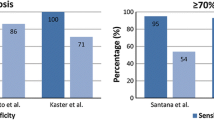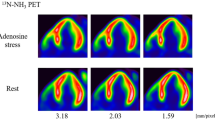Abstract
The quantification of global myocardial blood flow (MBF) by measuring coronary sinus flow by magnetic resonance (MRI) was demonstrated to be very well correlated with positron emission tomography (PET). We proposed a new method for the quantification of regional myocardial perfusion with MRI by the integration of MBF and first pass technique. The aim of this study was to validate this new method for quantification of regional perfusion by comparing it with 13NH13-PET in swine models of myocardial infarction and in humans in resting and hyperemic conditions. MRI and 13NH3-PET was performed in 2 healthy swine, 11 swine models of myocardial infarction (5 reperfused, 6 non reperfused) and in 12 humans at rest and during hyperemia. MBF was estimated by MRI through the quantification of coronary sinus flow and left ventricular (LV) mass. The upslope of signal intensity (SI-upslope) of each myocardial segment was obtained by the first pass gadolinium technique. Regional SI-upslope was indexed by the upslope of the entire left ventricular myocardium (global upslope). Regional myocardial perfusion was estimated as the product of MBF and SI-upslope/global upslope. Regional perfusion was also estimated by 13NH3-PET. A close agreement of the MRI and PET techniques for measurement of regional myocardial perfusion was found in all myocardial segments by Bland–Altman analysis (mean difference 5.1 %; limits of agreement, −37.2–27.5 %). With the integration of the first pass technique and the measurement of global MBF by coronary sinus flow/LV mass, MRI allows direct quantification of regional myocardial perfusion.







Similar content being viewed by others
References
Schelbert HR, Wisenberg G, Phelps ME, Gould KL, Henze E, Hoffman EJ, Gomes A, Kuhl DE (1982) Noninvasive assessment of coronary stenosis by myocardial imaging during pharmacologic coronary vasodilation. Vl. Detection of coronary artery disease in man with intravenous N-13 ammonia and positron computed tomography. Am J Cardiol 49:1197–1207
Araujo LI, Lammertsma AA, Rhodes CG, McFalls EO, Iida H, Rechavia E, Galassi A, De Silva R, Jones T, Maseri A (1991) Noninvasive quantification of regional myocardial blood flow in coronary artery disease with oxygen-15-labeled carbon dioxide inhalation and positron emission tomography. Circulation 83:875–885
Pingitore A, Lombardi M, Scattini B, De Marchi D, Aquaro GD, Positano V, Picano E (2008) Head to head comparison between perfusion and function during accelerated high-dose dipyridamole magnetic resonance stress for the detection of coronary artery disease. Am J Cardiol 101:8–14
Jerosch-Herold M, Wilke N (1997) MR first pass imaging: quantitative assessment of transmural perfusion and collateral flow. Int J Card Imaging 13:205–218
Patel AR, Antkowiak PF, Nandalur KR et al (2010) Assessment of advanced coronary artery disease: advantages of quantitative cardiac magnetic resonance perfusion analysis. J Am Coll Cardiol 56:561–569
Jerosch-Herold M, Swingen C, Seethamraju RT (2002) Myocardial blood flow quantification with MRI by model-independent deconvolution. Med Phys 29:886–897
Vallee J-P, Sostman HD, MacFall JR, DeGrado TR, Zhang J, Sebbag L, Cobb FR (1998) Quantification of myocardial perfusion by MRI after coronary occlusion. Magn Reson Med 40:287–297
Jerosch-Herold M, Wilke N, Stillman AE (1998) Magnetic resonance quantification of the myocardial perfusion reserve with a Fermi function model for constrained deconvolution. Med Phys 25:73–84
Schwitter J, DeMarco T, Kneifel S, von Schulthess GV, Ciopor Jörg M, Arheden H, Rühm S, Stumpe K, Buck A, Parmley WW, Lüscher TF, Higgins CB (2000) Magnetic resonance-based assessment of global coronary flow and flow reserve and its relation to left ventricular functional parameters: a comparison with positron emission tomography. Circulation 101:2696–2702
Koskenvuo JW, Sakuma H, Niemi P, Toikka JO, Knuuti J, Laine H, Komu M, Kormano M, Saraste M, Hartiala JJ (2001) Global myocardial blood flow and global flow reserve measurements by MRI and PET are comparable. J Magn Reson Imaging 13:361–366
Leor J, Tuvia S, Guetta V, Manczur F, Castel D, Willenz U, Petneházy O, Landa N, Feinberg MS, Konen E, Goitein O, Tsur-Gang O, Shaul M, Klapper L, Cohen S (2009) Intracoronary injection of in situ forming alginate hydrogel reverses left ventricular remodeling after myocardial infarction in Swine. J Am Coll Cardiol 54:1014–1023
Smith AC, Zellner JL, Spinale FG, Swindle MM (1991) Sedative and cardiovascular effects of midazolam in swine. Lab Anim Sci 41:157–161
Holland BJ, Printz BF, Lai WW (2010) Baseline correction of phase-contrast images in congenital cardiovascular magnetic resonance. J Cardiovasc Magn Reson 12:11
Meloni A, Al-Saadi N, Torheim G, Hoebel N, Reynolds HG, De Marchi D, Positano V, Burchielli S, Lombardi M (2011) Myocardial first-pass perfusion: influence of spatial resolution and heart rate on the dark rim artifact. Magn Reson Med 66:1731–1738
Vinnakota KC, Bassingthwaighte JB (2004) Myocardial density and composition: a basis for calculating intracellular metabolite concentrations. Am J Physiol Heart Circ Physiol 286:1742–1749
Lund GK, Wendland MF, Shimakawa A, Arheden H, Ståhlberg F, Higgins CB, Saeed M (2000) Coronary sinus flow measurement by means of velocity-encoded cine MR imaging: validation by using flow probes in dogs. Radiology 217:487–493
Aquaro GD, Todiere G, Barison A, Strata E, Marzilli M, Pingitore A, Lombardi M (2011) Myocardial blood flow and fibrosis in hypertrophic cardiomyopathy. J Card Fail 17(5):384–391
Nagel E, Klein C, Paetsch I, Hettwer S, Schnackenburg B, Wegscheider K, Fleck E (2003) Magnetic resonance perfusion measurements for the noninvasive detection of coronary artery disease. Circulation 108:432–437
Bellina RC, Parodi O, Camici P, Salvadori PA, Taddei L, Fusani L, Guzzardi R, Klassen GA, L’Abbate AL, Donato L (1990) Simultaneous in vitro and in vivo validation of nitrogen-13 ammonia for the assessment of regional myocardial blood flow. J Nucl Med 1990(31):1335–1343
Neglia D, Parodi O, Gallopin M, Sambuceti G, Giorgetti A, Pratali L, Salvatori P, Michelassi C, Lunardi M, Pelosi G, Marzilli M, L’Abbate A (1995) Myocardial blood flow response to pacing tachycardia and to dipyridamole infusion in patients with dilated cardiomyopathy without overt heart failure. A quantitative assessment by positron emission tomography. Circulation 92:796–804
Nekolla SG, Miethaner C, Nguyen N, Ziegler SI, Schwaiger M (1998) Reproducibility of polar map generation and assessment of defect severity and extent assessment in myocardial perfusion imaging using positron emission tomography. Eur J Nucl Med 25:1313–1321
Bland JM, Altman DG (1986) Statistical methods for assessing agreement between two methods of clinical measurement. Lancet 1:307–310
Florentine MS, Grosskreutz CL, Chang W et al (1986) Measurement of left ventricular mass in vivo using gated nuclear magnetic resonance imaging. J Am Coll Cardiol 8:107–112
Keller AM, Peshock RM, Malloy CR et al (1986) In vivo measurement of myocardial mass using nuclear magnetic resonance imaging. J Am Coll Cardiol 8:113–117
Awada S, Muzik O, Beanlands RSB, Wolfe E, Hutchins GD, Schwaiger M (1995) Interobserver and interstudy variability of myocardial blood flow and flow reserve measurements with nitrogen 13 ammonia-labeled positron emission tomography. J Nucl Cardiol 2:413–422
Ishida M, Ichihara T, Nagata M, Ishida N, Takase S, Kurita T, Ito M, Takeda K, Sakuma H (2011) Quantification of myocardial blood flow using model based analysis of first-pass perfusion MRI: extraction fraction of Gd-DTPA varies with myocardial blood flow in human myocardium. Magn Reson Med 66:1391–1399
Jerosch-Herold M, Swingen C, Seethamraju RT (2002) Myocardial blood flow quantification with MRI by model-independent deconvolution. Med Phys 29:886–897
Morton G, Chiribiri A, Ishida M, Hussain ST, Schuster A, Indermuehle A, Perera D, Knuuti J, Baker S, Hedström E, Schleyer P, O’Doherty M, Barrington S, Nagel E (2012) Quantification of absolute myocardial perfusion in patients with coronary artery disease: comparison between cardiovascular magnetic resonance and positron emission tomography. J Am Coll Cardiol 60:1546–1555
Jerosch-Herold M, Wilke N, Stillman AE (1998) Magnetic resonance quantification of the myocardial perfusion reserve with a Fermi function model for constrained deconvolution. Med Phys 25:73–84
Zierler KL (1962) Theoretical basis of indicator-dilution methods. Circ Res 10:393–407
Petersen SE, Jerosch-Herold M, Hudsmith LE, Robson MD, Francis JM, Doll HA, Selvanayagam J, Neubauer S, Watkins H (2007) Evidence for microvascular dysfunction in hypertrophic cardiomyopathy: new insights from multiparametric magnetic resonance imaging. Circulation 115:2418–2425
Conflict of interest
None.
Author information
Authors and Affiliations
Corresponding author
Rights and permissions
About this article
Cite this article
Aquaro, G.D., Todiere, G., Di Bella, G. et al. A fast and effective method of quantifying myocardial perfusion by magnetic resonance imaging. Int J Cardiovasc Imaging 29, 1313–1324 (2013). https://doi.org/10.1007/s10554-013-0220-z
Received:
Accepted:
Published:
Issue Date:
DOI: https://doi.org/10.1007/s10554-013-0220-z




